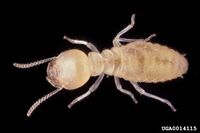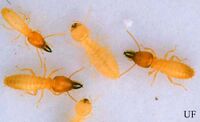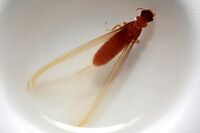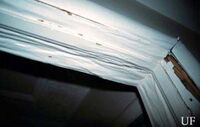Coptotermes formosanus
Coptotermes formosanus, or more commonly known as the formosan subterranenan termite, are considered to be a destructive type of termite insect species[1]. These small termite organisms were first found and are native to Taiwan and southern China[1].
Complete Taxonomic Hierarchy Classification
| Kingdom | Subkingdom | Infrakingdom | Superphylum | Phylum | Subphylum | Class | Subclass | Infraclass | Superorder | Order | Superfamily | Family | Subfamily | Genus | Species | |
|---|---|---|---|---|---|---|---|---|---|---|---|---|---|---|---|---|
| Classification | Animalia | Bilateria | Protostomia | Ecdysozoa | Arthropoda | Hexapoda | Insecta | Pterygota | Neoptera | Polyneoptera | Blattodea | Blatroidea | Rhino termitidae | Coptotermitinae | Coptotermes | Coptotermes formosanus |
[2].
Physical Characteristics Description

[4]

[1]

[5]
Coptotermes formosanus (formosan subterranean termites) have specific roles and functions which are specialized within their colonies[3]. The typical specialized roles within the colonies include workers, soldiers, and swarmers/reproductives[3].
The coptotermes formosanus workers are particularly challenging to identify and accurately differentiate from other types of termite species[3]. These coptotermes formosanus worker termites are usually entirely an off-white color, with antennas and general anatomy relatively similar to ants[3]. The coptotermes formosanus soldiers usually are seen as having an oval-shaped head with orange-brown color, an off-white body, and mandibles that are black in color[3]. Additionally, the soldiers contain a fontanel gland that releases a small quantity of a defensive liquid when they are disturbed, and this gland is found on the top of their head[3]. The coptotermes formosanus swarmers/reproductives are identified by their light-yellow hue, wings, as well as a body length of approximately 12 to 15 millimeters[3]. Out of all the three colony castes (worker, soldier, and swarmer/reproductive), reproductives are the only castes of comptotermes formosanus that is found to have wings[3]. The swarmers/reproductives have a total of four wings on their body, and these wings contain very visible dark veins in the direction toward the cranial end, and all of them are translucent with small hairs[3].
Geographical Range/Distribution
Coptotermes formosanus (formosan subterranean termite) is found to be native to China within the Palearchtic region, and it has spread to a multitude of other regions in the world[3]. In the 1600s, coptotermes formosanus was first reported to have been introduced to Japan from 14 southern China provinces[3]. Later it was discovered to have spread significantly into Hawaii within the late 1800s[3]. In 1950, they were found to have spread to Africa[3]. In 1960, they were introduced within the United States, and as of 2010 they distributed themselves primarily within the southeastern portion of the United States[3]. Most of the coptotermes formosanus residing in the United States are found in much of Florida, Lousiana, Texas, Mississippi, Alabama, North Carolina, South Carolina, and a smaller spread in Tennessee[3]. Additionally, they also reside in small areas of Hawaii and in San Diego County of California[3].
Habitat and Geographical Range/Distribution
Coptotermes formosanus reside in nests which are located underground[3]. Their nests are made up of a specific material called carton, which is created by themselves[3]. The finalized nest habitat can look as if it is a rocky structure as a result of the look and texture of the carton material[3]. These nests created by them can also be very large, in which it houses and shelters hundreds of thousands of termites within a singular colony[3]. Additionally, the carton material that is used to generate their nests is made up of soil, chewed up wood/plant materials, and their own saliva and feces[3]. Formosan subterranean termites have a tendency to live in wet and moist type environments, and can potentially be seen in forest type environments, in addition to more urbanized areas[3].
Furthermore, in the case where moisture and humidity levels are not ideal belowground, they might create nests above the ground in designated areas where the moisture and humidity levels are considered high[3]. Some more common places where these termites are able to locate higher moisture include various man-made type structures, such as on boats, porches, flat rooftops, or gutters[3]. As long as their is a place that has a food source for them a high levels of adequate moisture/humidity, then these termites will make an attempt to start successfully inhabiting that area[3].
Coptotermes formosanus has even been observed having the ability to survive within either dead or alive tree trunks, in addition to buildings and home walls[3]. If this termite species can find the right food source and a high humidity environment, they have a very high likelihood of successful survival and thriving[3].
Lifespan
The queen of the colony of formosan subterranean termites have the longest lifespan longevity out of all the other castes (worker, soldier, and swarmer/reproductive)[3]. The queen of a colony can have a lifespan longevity of up to approximately 15 years[3]. In contrast, other individual termites in other castes, such as workers, soldiers, and swarmers/reproductives, usually live for a much shorter time frame, making them have a more limited lifespan duration[3].
Diet
This organism usually consumes wood for their food[3]. When they are not eating wood, they could be eating other foods found within their environment and habitats that have cellulose in them, like cardboard or paper[3]. Bacteria live in their bodies within the digestive system in order to assist in the break down and absorption of the cellulose compound in order for these termites to digest their food with less effort[3].
Consequences to Human Environments
One individual formosan subterranean termite does not feed on a larger quantity of wood when compared to a single native subterranean termite[1]. However, due to formosan subterranean termites having a large population, one formosan subterranean termite colony has the potential to create more structural damages to made-made structures, such as buildings or homes, within a quicker time frame[1]. In serious termite infestations, formosan subterranean termites almost completely hollow out wooden surfaces, only leaving behind a paper-thin weak surface, and a hollow wood surface can also be identified by if it looks blistered or peeled[1].

References
[1] Featured Creatures Entomology & Nematology. (n.d.). . https://entnemdept.ufl.edu/creatures/urban/termites/formosan_termite.htm#top
[2] ITIS - Report: Coptotermes formosanus. (n.d.). . https://www.itis.gov/servlet/SingleRpt/SingleRpt?search_topic=TSN&search_value=650469#null.
[3] Relph, A. E. K. M. R. (n.d.). Coptotermes formosanus. https://animaldiversity.org/accounts/Coptotermes_formosanus/.
[4] formosan subterranean termite (Coptotermes formosanus ). 2016, January 23. . http://www.invasive.org/browse/detail.cfm?imgnum=0014115.
[5] Phd, M. M. 2013, May 23. Insects in the City: Identifying Formosan termites.